The Maui Jim Molokai Challenge is a “challenge” no matter what the conditions – windy or calm, the heat and the distance make this a daunting race. So how do the paddlers prepare for the race? Here’s what you need to know about the race, with insights from some of this year’s competitors.
The Race Course
The Molokai Challenge is one of the oldest surfski races in the world, being run for the first time in 1977 across the Kaiwi Channel from Kaluakoi Beach on Molokai to the Manalua Beach Park on Oahu.

For the very latest NOAA forecast, click here.
The race is just over 53km long and paddlers face a number of obstacles:
- Just getting off the beach before the start can be problematic when a NW swell is running.
- The sheer distance and heat are a major challenge, especially for paddlers coming from colder countries, and even more especially when the trade winds aren’t blowing.
- Currents can play a huge part in the race and knowing what line to take and whether to head north of the rhumb line can make or break your race.
- Towards the finish, the paddlers have to negotiate the notorious China Wall where there’s a wave that can boost your speed – or drag you over a reef potentially breaking your ski (and you!)
- And the last 3km are on ever flatter, protected water, culminating in a 500m sprint to the finish, potentially into the wind.

2019 Conditions
The current NOAA forecast for the Kaiwi Channel (as at 24 May) says,
Sunday: East winds 15 knots. Wind waves 5 to 6 feet. Mixed swell northwest 4 feet and south 4 feet. Isolated showers.
The air temperature is forecast to be in the high 20sC/70sF. The water temperature is currently near 27C/80F… so it’s really, really hot. Those “isolated showers” might be extremely welcome.
The first challenge facing the paddlers will be to get through the surf before the start. The beach is fully exposed to the NW swell and shelves steeply so that there’s a fierce shore break. With swell that big, it can break further out as well.
The key to getting out safely is patience and to wait for a gap between the sets.
Assuming the forecast is correct, and the easterly wind blows at 15kt, there will be fast moving runs to catch. But the oncoming ocean swell will make the conditions bumpy, technical and tiring.
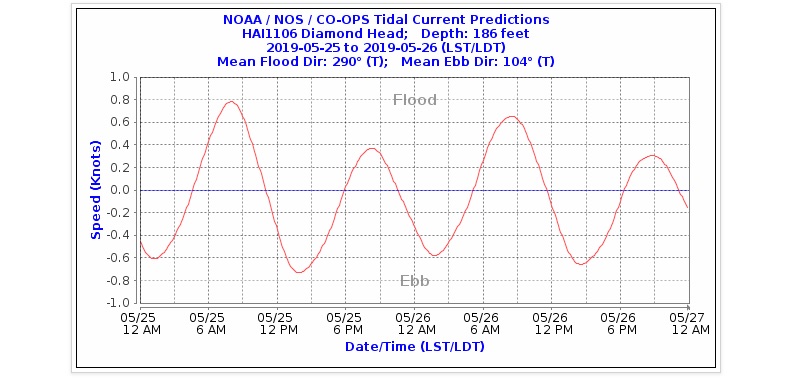
The current should be running with the paddlers for two thirds of the race and they should finish at the ebb without too fierce an opposing current (but the waters south of Oahu are notorious for behaving in an unexpected way...)
Cory Hill
Defending champion (and current world champion) Cory "Chill" Hill said he doesn't change much for Molokai. "Just a longer race," he said, "Keep it simple".
He'll be paddling a full carbon Fenn Elite S.
- Fluids: Watered down Powerade, and just the Fenn juice bottle of around 1.7l, slotted into place at the front of the footwell. "I make sure I'm extremely well hydrated leading into the race," he said.
- Clothing: Shorts and shirt. (He does wear the Vaikobi V Cold range in winter, but not in hot weather.)
- No sunnies, no paddle grips.
- No wave deflector, but "Joshy Fenn is making some really good ones, so I'll be training and racing with his product."
he also shared some of his thoughts about racing, family life and the race itself with Tim Altman:
Clint Robinson
The highly experienced (and three-time winner) Clint Robinson isn’t expecting the records (set last year) to be broken.
Tim Altman spoke to him a few days ago about his expectations for the race, and Clint shared some insights about the race and some of the other competitors!
Oscar Chalupsky
The 12-time winner of the race is notorious for using hardly any liquids during long distance races.
This year he’s paddling a Nelo 600 double with Seth Koppes.
His setup includes:
- No gels, no juice (although he might, he said, take 200ml of water from his escort boat during the race). (Both men are Keto Diet adherents.)
- Two GPS on his footstrap; one for navigation, one with speed, HR, distance and time displayed.
- He’ll be wearing long pants (“shorts tend to ride up at speed”) but a short-sleeved shirt and “enough” sunscreen.
- The boat has a wave deflector on the front deck and Oscar says he always checks the rudder lines, particularly.
Oscar’s predictions for the race? Cory Hill, Pat Dolan, Hank McGregor, Clint Robinson, Mackenzie Hynard, Austin Keiffer, Michael Booth and Alastair Day.
Oscar's been staying on Big Island in the lead up to the race and posted some phenomenal footage of paddling in the channel between Big Island and Maui a few days ago:
Hank McGregor
The three-time Molokai champion is back to have another crack at the race - and is featured on this clip filmed by Aussie Jim Walker, catching a loooooong run back into the beach in Oahu.
Hayley Nixon
South African, Durban-based Hayley Nixon is the current ICF Ocean Racing World Champion and won both the Double and Single Surfski Championships in South Africa in April in Cape Town.
Part of the Shaw and Partners Team, she paddles a Carbonology Sport Pulse surfski.
Arriving in Hawaii a week ago, she’s feeling at the top of her game for the race. Her preparations:
- No gels: “I don’t take gels, I’m not a sugar-based paddler. More of a high-fat, low carbs. If I have taken any kind of gel in the past, it’s in the form of a nut-butter.” She doesn’t like gels in any case because of the hassle and time it takes to open and eat them. She admits to carrying them with her sometimes just in case, but has never had to use them in a race.
- Fluids: Hayley uses water with electrolytes/rehydrate, not reliant on sugar. She’ll have backup fluids on her escort boat, given the heat and length of this race. The fluids will be in a fridge bottle mounted on the boat. (She doesn’t like the weight of camelback bags, although in short races she sometimes uses a small one on the front of her PFD.)
- Clothing: She’ll use a Vaikobi Ocean long-sleeved top, high UV resistance. Aside from the sun screening, it gets wet which helps keep her cool. She said she’d probably wear shorts though; lots of zinc on the face, hat, maybe even sunglasses, “If it’s sunny, the reflections are quite hectic.”
- Boat prep: She’s never used a wave deflector.
- Paddle grips: She uses silicone tape on the paddles, bought from the hardware store and replaced every couple of months. “Quite a few people use tape,” she said, “or o-rings to help position hands on the paddle shaft.”
Tim Altman interviewed Hayley a few days ago on Oahu:
Rachel Clarke
The New Zealander has plenty of experience in Hawaii:
- 2018: 2nd (just over a minute behind Hayley Nixon)
- 2017: 1st
- 2016: 2nd
- 2014: 1st
She’s paddling an Epic V11 Elite, the black surfski weighs in at under 9.5kg/21lb.
In March this year, Rachel completely dominated the King and Queen of the Harbour race in demanding, technical downwind conditions in Auckland.
She said, “My training has been going well, I feel like I’m in the best shape I’ve been in so we shall see how it unfolds on Sunday!”
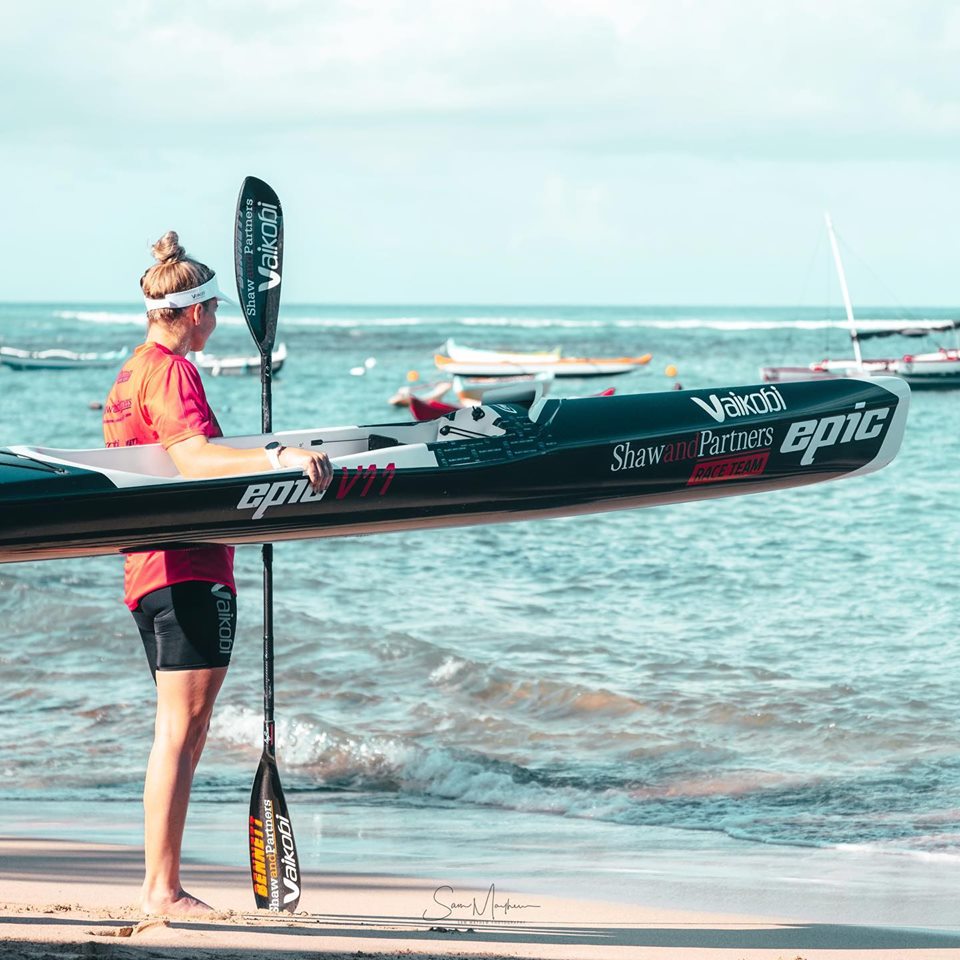
Her race preparation:
- Fluids: “I use electrolytes in my bladders; I’ll have one in my footwell with the tube pegged to my shirt.” She’ll have more on the escort boat, and when she needs a replacement, her partner and second, Sam Mayhew, will “jump in and change it out for a new one.”
- Gels: “Absolutely, I think these are key!”
- Boat: If it looks as though it’s going to be a downwind, then she’ll put a wave deflector on the boat.
- Clothes: “I like to wear a singlet in races and shorts, unless it’s freezing.”
- GPS: For navigation, she’ll rely on the escort boat, but in the ski, her GPS will be displaying speed and heart rate.
To prepare for the Hawaiian heat, Rachel spent sessions in a sauna at home in New Zealand. Having prepared inadequately for my own race back in 2008, I can attest to the importance of being acclimatized; the humidity adds to the stress of the high temperature.
Georgia Laird
Tasmanian Georgia Laird is tackling Molokai for the first time. She should be in contention, having won the 2018 Perth Doctor (beating Hayley Nixon). Tim Altman interviewed her and her coach, Naomi Flood.
Mackenzie Hynard
No stranger to Molokai, Macca came 6th in the 2018 event. The 24-year-old is one of the younger paddlers who’ll be near the front of the race.
Macca is sponsored by Think Kayaks, the Think UNO his weapon of choice (and before I get a million queries, in this video clip of Macca riding a wave in Honolulu, he was trying out a Think Ion, but that's not his race boat!!)
Race prep:
- Nutrition: Mars bars stored “up one side of paddle shorts”, 2l of fluid (1l water, 1l Powerade).
- Boat: Wave deflector on the deck, otherwise no special prep on the boat.
- Clothing: Stock Vaikobi shorts and shirt with a hat. Plenty of zinc and sunscreen.
- GPS Setup: Macca doesn’t bother about his heart rate, “I just use it [the GPS] for splits.” Neither does he use it for navigation, “Take a line and hope it works!”
- Attitude: “Get the mind in the game of hurting for what may be 4 ½ hours. Anything under is a bonus.”
Who does he rate in the race?
“Cory, Hank and Clint; their experience is so great. Then Pat Dolan with his local experience.
“Austin Keiffer. Young and new blood of Josh Fenn and Nick Gale.
“Boothy, even though on the SUP program no doubt will be up front.
“Ali Day, coming off successful Australian Ironman season and have won the most Coolangatta golds ever will be there, especially if it’s flat or small, as he will grind for days.”
Austin Kieffer
Kieffer lives in Sausalito, California and has been competing around the world in surfskis since 2016. Most notably he scored a podium place at the Perth Doctor in 2017. In 2018, he scored a 5th at the Irish Coast Paddling Championships, but injured his shoulder, scuppering his chances of another podium position at the 2018 Doctor.
He paddles the Fenn Elite S in full carbon lay-up. When I contacted him, he was scrambling to get a footplate problem repaired in time for the race. “Drawbacks of being the last Fenn athlete to arrive, I guess,” he laughed.
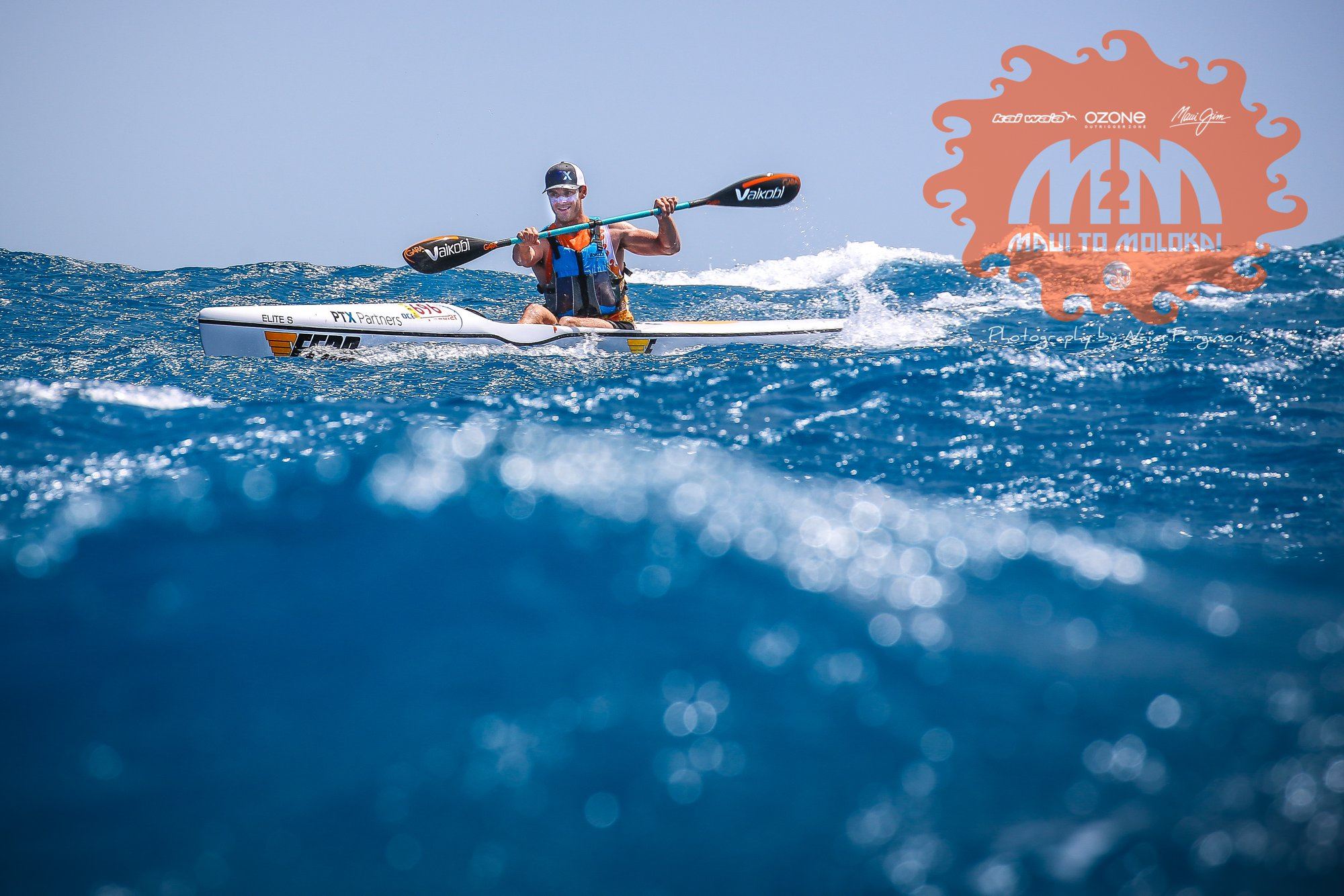
Austin Kieffer paddled the Maui to Molokai race earlier this year
His race day prep includes:
- Clothes: Vaikobi Ocean V Cold Shorts. “I use these because they are a little thicker,” he said, “and cut down on bum chafe. Since they’re always wet, they don’t make me hot.” Vaikobi ocean performance shirt, with the sleeves removed (“Kinda my signature, haha”).
- He’ll be using sunscreen but, “I’m super anal about getting my hands greasy so I’ll put it on way before the race and then wash my hands a lot. Definitely need it for this race, though.”
- No wave deflector. “I’ve trained without it and don’t really need one, aside from which, they get knocked off so often during event transportation and I don’t want to want it and then not have it!”
- Fluids: “I’ve really tried to dial in my nutrition and hydration more this year,” he said. He uses plain drinking water with perhaps just a touch of Numm for electrolytes depending on the day and will have about 2.5l in a juice bag placed in front of his footplate.
- Gels: Austin will be taking 6 gels, planning to eat 3-4 of them. “Last year I needed more than I had,” he said. “I’ll probably take one every 45min, washed down with the plain water, and I want at least 2 spare.”
- GPS: He works with Time, distance, heart rate and average lap speed with auto lap on 1km. “The HR will really just be something I’ll pay attention to only if I’m seriously in the red or out in front,” he said. He added: “I’m racing to podium and as long as the thing doesn’t stop, I’ll suffer through any HR!”
- Escort driver: Unfortunately, his known and trusted escort driver pulled out so he’ll be working with someone new. “But my dad will be my second, on the boat.”
Austin said candidly that his money is on Cory Hill to win the race. “But,” he said, “I’m going to set myself up with the best possible chance, and for sure I’m gonna be on that podium!”
“This was one of the toughest races I’ve done in a long time!”. When a campaigner like Oscar Chalupsky says that, you know the conditions must have been challenging. Chalupsky had been in New Zealand for a two-week trip, culminating in the Vaikobi King and Queen of the Harbour race in Auckland.
Tough Course
Given the forecast 20kt Northeaster, the race directors chose a 23km route known to the locals as the “Gnarly Northerner” from Whangaparaoa Peninsula on Auckland’s north shore to finish at Takapuna Boating Club.

The first leg of the course was a flat-out 3km grind into the wind and waves, and any thought of an easy downwind was quickly dashed as the paddlers rounded the buoy.
“Once we turned, I thought it would be an easy downwind,” said Chalupsky. “But I was mistaken!” In fact they were faced with almost side-on wind and waves, extremely testing, technical conditions.
Looking at some of the race tracks on Strava, you can see how they were catching runs by turning right and then working left to stay on course for Takapuna.
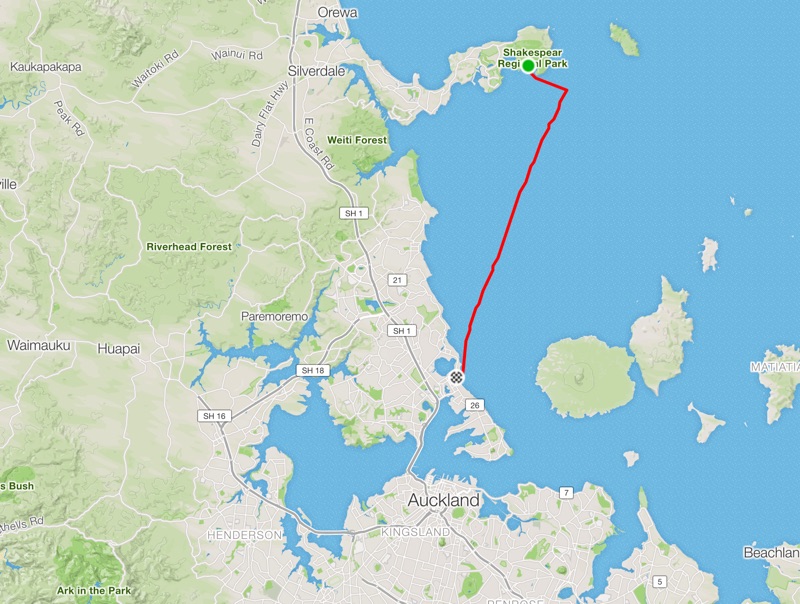
Walking away with it
Defending champion Andy Mowlem reached the turn-buoy first and simply paddled away from the rest of the field, finishing in 1:34:54, a massive 3 ½ minutes ahead of second placed Sam Mayhew.
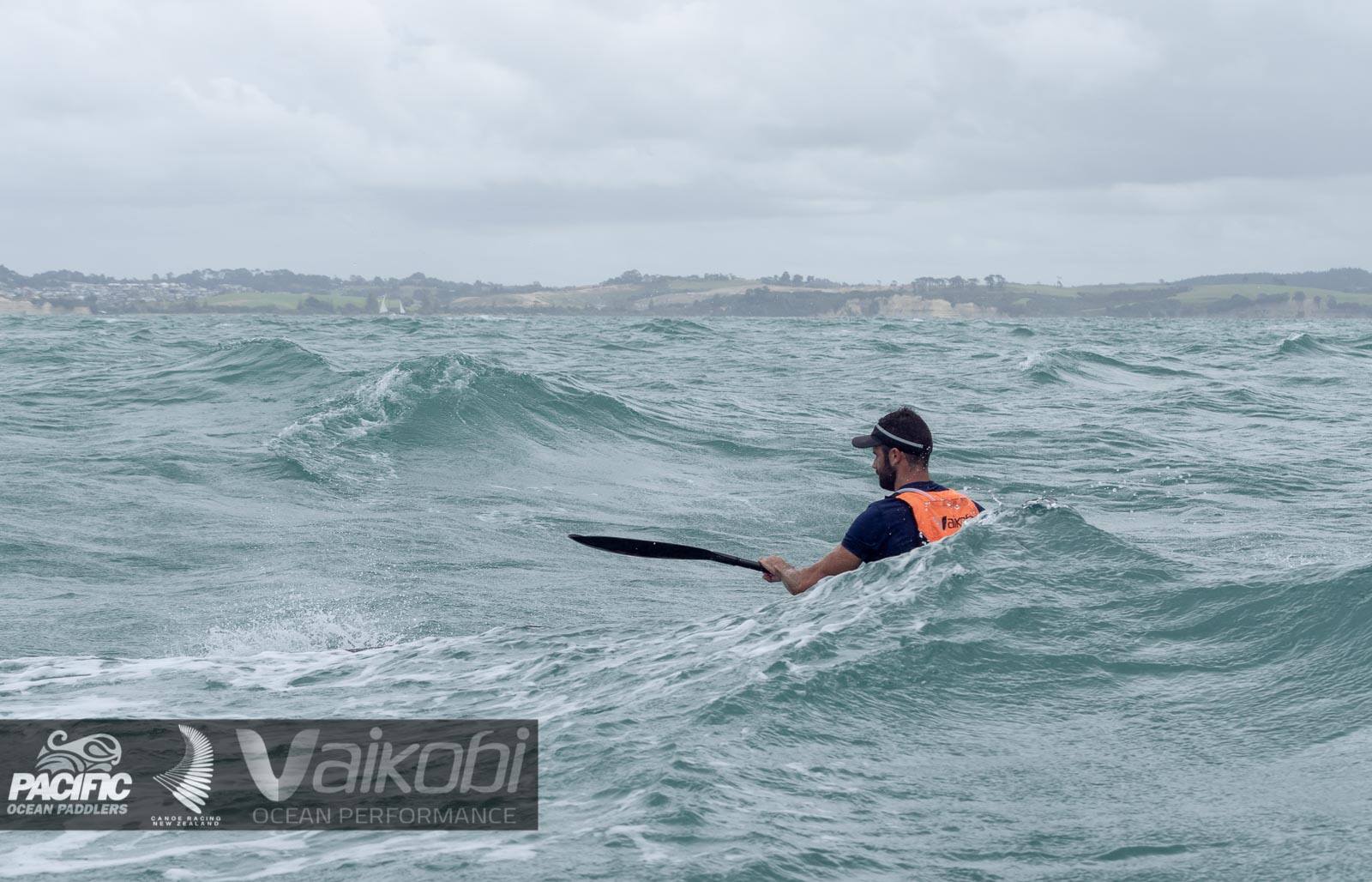
Andy Mowlem hurtles downwind...
The real race was for second place; a tremendous dice between Mayhew, Toby Brooke and Oscar Chalupsky.
Takapuna club member Mayhew, with the benefit of local knowledge, took an inside line to the final turn and pipped Brooke by seven seconds with hard charging Chalupsky (“you can see from my heart rate that I pushed my hardest in a long while!”) just two seconds behind.
"Finally cracked the podium!" said an elated Mayhew on Facebook. "2nd place at the King of the harbour which is also the NZ Ocean Ski Nationals!"
"6 years ago I started falling out of a SLS ski for the first time," he added, "and later that year I did my first king of the harbour. I was near last but I was hooked..."
In the women’s race, Rachel Clarke dominated, coming in 7th overall in the single skis with Rebecca Cole and Danika Mowlem coming in 2nd and 3rd respectively.
“VERY technical conditions out there today,” said Clarke, “… which I loved!” It was Clarke's seventh win in this iconic event.
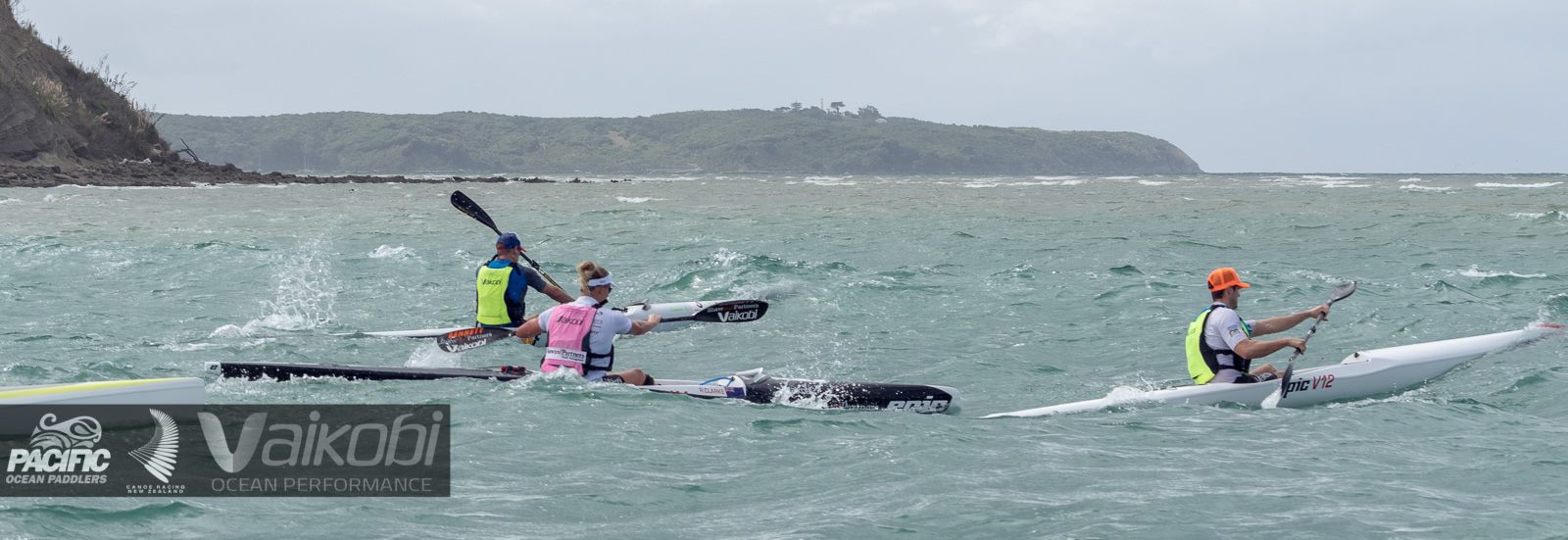
Rachel Clarke heads out into the chop at the start...
Yeeeeeha! A couple of strokes and the ski started accelerating, 16kph, 20kph, 26kph… Whooomph! The spray deflector threw a mass of water arcing into air… Blinded, unbalanced, keep it going, paddle, paddle…!
There are quite a few how-to-remount videos on YouTube - but once again Oscar shows us the best technique for remounting and he makes it look easy (it is easy, you just need to practise!). Remounting is one of the core skills in surfski paddling - along with the brace stroke. Best you don't come out of your ski at all, but if you do, this is the best and easiest way to get in again.
“Kenny flew off the line,” said Sean Rice. “I had to consolidate, stay on his wave to the buoy. I knew I couldn’t give him an inch… I went hard for 3km to try to open a gap; looked around, he was still right there!” And what he didn’t know was that “Flash” Gordan Harbrecht was also right behind him…
The paddlers were dicing in the first big international race of the European season: EuroChallenge 2018 off La Vila Joyosa, Spain.
"There is no good reason to use feather angle on your paddle," said Oscar Chalupsky (in his usual assertive manner.) The surfski.info forum has seen something of a debate raging on this topic in the last couple of weeks; I knew that Oscar had been encouraging beginners to use zero feather, so I called him to ask for his views.
"Molokai" You just have to utter that name, and everyone in the surfski community knows what you're talking about: the 53km open ocean crossing from Molokai to Oahu across the Kaiwi Channel. One of the oldest surfski races in the world, it was long regarded as the surfski world championships; and in the 2017 race only three of the past 43 year's winners weren't back to tackle the challenge once more.
The Kaiwi Channel has a reputation for massive downwind conditions; with a fetch of several thousand km, the NE trades can produce ferocious swell. In 2017, however, the winds didn't arrive on the day and the paddlers faced a challenge of a different kind: heat, a head-on current, a slow heaving, seasickness inducing swell...! (Those were the conditions I faced in 2008 - and it was one of the toughest days of my life.)
This video was released 6 months ago - but is well worth taking the time to review. And with the Maui Jim Molokai Challenge coming up on Sunday, May 27, 2018, it's a great reminder to make your bookings and to keep on training hard... And train for flat water, just in case.
"Fortunately the camera died for the last 5km, because I was cursing..." said Oscar Chalupsky. "It was flat, hot, headwind… and I was blown!"
"It was an adrenalin rush and I can't wait to do it again…" said Vinnie Cicatello. He'd just completed his first ever Miller's Run, in the back of a double surfski with Oscar Chalupsky.
A few days after winning "Ze Caribbean Race", here's Oscar coaching a couple of paddlers (including his boss) on downwind technique.
I've had the enormous pleasure of paddling a number of times with Oscar in doubles on our beloved Miller's Run downwind route here in Cape Town, and I can say with all honesty that it's been a revelation and inspirational every time.
As you can see (and hear, as he barks at his pupils!), Oscar's basic mantra is to paddle early and stop paddling early and work with the energy of the waves. On many other occasions (although he doesn't mention it in this video) he's described taking a couple of "explosive" power-strokes to get onto the run.
Don't try to catch every run
When I paddled doubles with him, I was astonished at how many waves he didn't take: he has an uncanny ability to feel whether the wave is the right one or not. If not, he lets it roll under him, taking the next one (or the one after that). But more often then not, he then pops back over the one or two that he discarded, making up the distance and more. This kind of skill takes time in the boat to acquire - at the beginning of a downwind career, the novice tries too hard, fails to get over too many runs, using too much energy - but you learn over time how to use the least amount of power to catch the run and then to milk it for all the energy it contains.
Scanning
Another of Oscar's mantras is too keep scanning 45 degrees either side of your course, looking for the next dip in the water, or the next shoulder of the wave in front. Frequently he'll steer a kind of S-curve, turning left or right, keeping the speed up, before turning back onto the wave.
If you ever get the chance to ride doubles with Oscar (or any of the other top downwind elites), don't hesitate! You'll learn more in five minutes than you can imagine - and you'll be inspired to get straight back out to try it for yourself.
Latest Forum Topics
-
- Nelo Vanquish AIR review
- 15 hours 12 minutes ago
-
- Paddling with rotator cuff injury
- 2 days 7 hours ago

